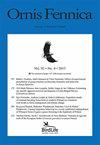Factors affecting apparent survival and resighting probability of wintering mallards Anas platyrhynchos
IF 1.2
4区 生物学
Q2 ORNITHOLOGY
引用次数: 1
Abstract
Survival of adults is a key demographic parameter affecting avian population dynamics. In urban areas, e.g., city parks, birds stay in winter in large numbers where they have access to a multitude of food sources due to human activities, which is one of the key factors that attract birds into the cities. Our study estimates apparent survival of mallard ducks Anas platyrhynchos between non-breeding seasons in a small town in the coldest region in north-eastern Poland between 2005 and 2017. We found lower survival estimates for females (juveniles: 0.54; adults: 0.59) than males (juveniles: 0.76; adults: 0.72) and probabilities of resighting individuals in the next non-breeding season were higher if the bird was resighted in the study area during the prior breeding period. Thus, we conclude that sedentary mallards from the local urban population have relatively high survival, which may be explained by lower pressure from raptors, lack of hunting and higher winter temperatures in the urban site. Additionally, winter temperature was negatively related to resighting probability in the next non-breeding season. Resighting probability was time-dependent with a bimodal pattern with maximal estimates of 0.48 in 2007/2008 and 0.98 in 2013/2014, 0.98 in 2014/2015, 1.00 in 2015/2016. These results are most likely related to volunteers’ activity that increased due to organized official competition with special awards during those seasons. Considering the fact that the type of ring (metal or plastic coloured) significantly influenced the probabilities of resighting of individuals, it is recommended that apparent survival studies on birds be conducted using colour rings. Moreover, we encourage to collect more capture-mark-recapture data to enable accurate estimations of duck survival, which not the least is a prerequisite for successful management and conservation efforts.影响东北鸭越冬期表观存活率和重寄生概率的因素
成虫的存活率是影响鸟类种群动态的一个关键人口统计学参数。在城市地区,例如城市公园,鸟类在冬季大量停留,由于人类活动,它们可以获得多种食物来源,这是吸引鸟类进入城市的关键因素之一。我们的研究估计了2005年至2017年间,在波兰东北部最寒冷地区的一个小镇上,绿头鸭Anas platyrhynchos在非繁殖季节的明显存活率。我们发现,雌性(幼鸟:0.54;成年鸟:0.59)的存活率估计值低于雄性(幼鸟∶0.76;成年鸟∶0.72),如果该鸟在前一繁殖期在研究区域被重新安置,则在下一个非繁殖季节重新安置的概率更高。因此,我们得出结论,当地城市种群中久坐不动的绿头鸭存活率相对较高,这可能是因为猛禽的压力较低、缺乏狩猎以及城市地区冬季温度较高。此外,冬季温度与下一个非繁殖季节的重新定居概率呈负相关。辞职概率与双峰模式有关,2007/2008年和2013/2014年的最大估计值分别为0.48和0.98,2014/2015年和2015/2016年分别为0.98和1.00。这些结果很可能与志愿者的活动有关,由于在这些季节有组织的官方比赛和特别奖项,志愿者的活动有所增加。考虑到环的类型(金属色或塑料色)显著影响个体重新定居的概率,建议使用色环对鸟类进行明显的生存研究。此外,我们鼓励收集更多的捕获标记再捕获数据,以准确估计鸭子的存活率,这也是成功管理和保护工作的先决条件。
本文章由计算机程序翻译,如有差异,请以英文原文为准。
求助全文
约1分钟内获得全文
求助全文
来源期刊

Ornis Fennica
生物-鸟类学
CiteScore
2.00
自引率
0.00%
发文量
14
审稿时长
>12 weeks
期刊介绍:
Ornis Fennica is a peer-reviewed international ornithological journal published by BirdLife Finland. Ornis Fennica publishes analytical and experimental papers on the ecology, behaviour and biogeography of birds. Ornis Fennica prefers studies concerning Fennoscandian species, but other novel contributions of general interest are most welcome as well.
Ornis Fennica is an open-access journal without page charges for publication. All published articles (from 1924 onwards) are freely available from the journal website. First decisions are usually made within three months of submission.
 求助内容:
求助内容: 应助结果提醒方式:
应助结果提醒方式:


